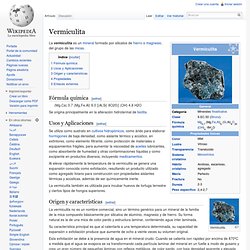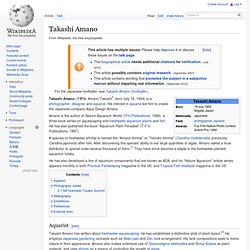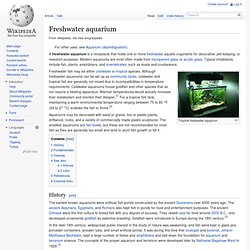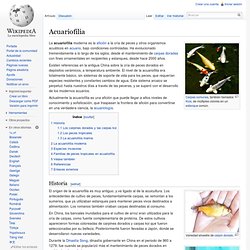

Growlux. Vermiculita. Vermiculita.

La vermiculita es un mineral formado por silicatos de hierro o magnesio, del grupo de las micas. Fórmula química[editar] (Mg,Ca) 0.7 (Mg,Fe,Al) 6.0 [(Al,Si) 8O20)] (OH) 4.8 H2O. Takashi Amano. Takashi Amano (天野尚, Amano Takashi?

, born July 18, 1954) is a photographer, designer and aquarist. His interest in aquaria led him to create the Japanese company Aqua Design Amano. Amano is the author of Nature Aquarium World (TFH Publications, 1994), a three-book series on aquascaping and freshwater aquarium plants and fish. He has also published the book "Aquarium Plant Paradise" (T.F.H. Publications, 1997). A species of freshwater shrimp is named the “Amano shrimp” or "Yamato shrimp" (Caridina multidentata; previously Caridina japonica) after him.
He has also developed a line of aquarium components that are known as ADA, and his “Nature Aquarium” article series appears monthly in both Practical Fishkeeping magazine in the UK, and Tropical Fish Hobbyist magazine in the US. Aquarist[edit] Takashi Amano has written about freshwater aquascaping. He founded Aqua Design Amano Co., Ltd. in 1982, providing aquatic plant growing equipment. Liebig's law of the minimum. Liebig's law of the minimum, often simply called Liebig's law or the law of the minimum, is a principle developed in agricultural science by Carl Sprengel (1828) and later popularized by Justus von Liebig.

It states that growth is controlled not by the total amount of resources available, but by the scarcest resource (limiting factor). Applications[edit] [clarification needed] This concept was originally applied to plant or crop growth, where it was found that increasing the amount of plentiful nutrients did not increase plant growth. Only by increasing the amount of the limiting nutrient (the one most scarce in relation to "need") was the growth of a plant or crop improved. Example[edit] Liebig's barrel Dobenecks[1] used the image of a barrel—often called Liebig's barrel—to explain Liebig's law.
Scientific applications[edit] For instance, in the equation below, the growth of population is a function of the minimum of three Michaelis-Menten terms representing limitation by factors and. Freshwater aquarium. Tropical freshwater aquarium Freshwater fish may be either coldwater or tropical species.

Although freshwater aquariums can be set up as community tanks, coldwater and tropical fish are generally not mixed due to incompatibilities in temperature requirements. Coldwater aquariums house goldfish and other species that do not require a heating apparatus. Warmer temperatures would actually increase their metabolism and shorten their lifespan.[1] For a tropical fish tank, maintaining a warm environmental temperature ranging between 75 to 80 °F (24 to 27 °C) enables the fish to thrive.[2] History[edit] The earliest known aquariums were artificial fish ponds constructed by the ancient Sumerians over 4500 years ago. In the later 18th century, widespread public interest in the study of nature was awakening, and fish were kept in glass jars, porcelain containers, wooden tubs, and small artificial ponds. During the 19th century the idea of the "balanced aquarium" was developed. Carassius auratus. La carpa dorada (Carassius auratus auratus) es un pez de la familia de los ciprínidos, la carpa dorada es el pez más popular y vendido en el mundo entero; se le encuentra en la gran mayoría de las tiendas de acuarios, donde es posible conseguir algunas de las 125 variedades reconocidas actualmente.

La carpa dorada desciende del carpín (Carassius carassius) que habita el este de Asia, pez alargado y color marrón, larguirucho de apariencia similar a la carpa dorada común. Fue a través de numerosas mutaciones y a la crianza selectiva que se originaron las variedades de Carpa dorada que conocemos hoy en día. Los primeros en criar y reproducir estos hermosos peces fueron los chinos hace más de mil años. En ese entonces las carpas doradas estaban destinados a miembros de la realeza, quienes los conservaban en grandes recipientes de cerámica y más adelante en peceras de vidrio.
Años después se introdujeron en los estanques que rodeaban los jardines reales, lo que facilitó su reproducción. Pterophyllum. Species[edit] There are currently three recognized species in this genus:[1] History[edit] The freshwater angelfish (Pterophyllum scalare) was described in 1824 by F.

Schultze. Pterophyllum is derived from the Greek pteron (fin/sail) and phyllon (leaf). In 1906 J. Angelfish were bred in captivity for at least 30 years prior to P. leopoldi being described. Acuariofilia. Existen referencias en la antigua China sobre la cría de peces dorados en depósitos cerámicos, a temperatura ambiente.

El nivel de la acuariofilia era totalmente básico, sin sistemas de soporte de vida para los peces, que requerían especies resistentes y constantes cambios de agua. Este sistema arcaico se perpetuó hasta nuestros días a través de las peceras, y se superó con el desarrollo de los modernos acuarios. Actualmente la acuariofilia es una afición que puede llegar a altos niveles de conocimiento y sofisticación, que traspasan la frontera de afición para convertirse en una verdadera ciencia, la acuariología. Pterophyllum.